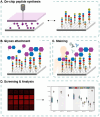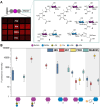Synthetic High-Throughput Microarrays of Peptidoglycan Fragments as a Novel Sero-Diagnostic Tool for Patient Antibody Profiling
- PMID: 39945485
- PMCID: PMC12036811
- DOI: 10.1002/anie.202420874
Synthetic High-Throughput Microarrays of Peptidoglycan Fragments as a Novel Sero-Diagnostic Tool for Patient Antibody Profiling
Abstract
Peptidoglycan (PGN) is a complex biopolymer crucial for cell wall integrity and function of all bacterial species. While the strong inflammatory properties of PGN and its derived muropeptides are well-documented in human innate immune responses, adaptive immunity, including antibody responses to PGN, remain inadequately characterized. Microarray technology represents a cost- and time-efficient method for studying such interactions. Our laser-based technology enables the high-throughput synthesis of biomolecules on functionalized glass slides. Here, this on-chip synthesis was developed for PGN fragments, to generate a variety of 216 stem peptides and attach six different glycan moieties that are major structural components of bacterial cell walls. Thereby, 864 PGN fragments from different Gram-negative and Gram-positive species were generated. The arrays were validated with four different monoclonal antibodies against PGN or poly-N-acetyl glucosamine and identified their epitopes. Finally, proof of concept for antibody profiling in patient samples was performed by comparing a panel of well-characterized plasma samples of epidermolysis bullosa (EB) patients suffering from (chronic) wounds with Staphylococcus aureus infection. EB patients show an increased response to the muramyl dipeptide. Therefore, this novel high-throughput PGN glycopeptide microarray technology promises to identify distinct antibody profiles against human microbiomes in diseases, notably in those involving the intestine.
Keywords: antibodies; autoimmunity; epidermolysis bullosa (EB); laser-induced forward transfer (LIFT); solid phase synthesis.
© 2025 The Author(s). Angewandte Chemie International Edition published by Wiley-VCH GmbH.
Conflict of interest statement
F.F.L. is named on a patent application related to laser‐based microarray synthesis. P.H.S. declares a significant financial interest in GlycoUniverse GmbH & Co. KGaA, the company that commercialized AGA synthesis instruments, building blocks, and other reagents. All other authors declare that they have no competing interests.
Figures





References
-
- M. F. Dwayne C. Savage, Bacterial Adhesion, Springer US, Boston, MA, 1985.
MeSH terms
Substances
Grants and funding
LinkOut - more resources
Full Text Sources

